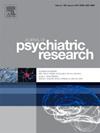Exploring the connections between Gaming Disorder and real-life problems through network analysis
IF 3.7
2区 医学
Q1 PSYCHIATRY
引用次数: 0
Abstract
Recent research on Gaming Disorder (GD) has emphasized the important role of experiences related to psychiatric distress and functional impairments in GD, however, little is known about the complex relationship between its symptoms and specific associated problems. The present study recruited a nationally representative sample of 1,074 British adults to investigate the relationship between GD Symptoms and GD Problems within a network analysis framework among gamers. The results of the node centrality analysis revealed that significant distress/impairment was central, exhibiting the highest betweenness, closeness, and strength, and acted as a critical bridge linking other symptoms. Moreover, impaired control was the most influential node in terms of its potential to affect other nodes in the network, implying that both nodes are core symptoms of GD. Additionally, bridge centrality analysis suggested that while significant distress/impairment directly connected GD Symptoms with GD Problems, the nodes related to problems served as gateways between the two identified GD core symptoms, further propagating effects across the network. These findings present important implications as targeted interventions aiming at alleviating the experience of psychiatric distress and functional impairments associated with GD, while improving gaming behavior self-regulation may lead to cascading benefits reducing the overall intensity of symptoms experienced. Interestingly, the findings also supported the notion that GD Problems acted as bridges between the two GD core symptoms identified (i.e., significant distress/impairment and impaired control), signifying that they connect the GD core symptoms, allowing the effects of one symptom to influence the other while intensifying the overall experience of symptomatology.
通过网络分析探索游戏障碍与现实生活问题之间的联系
最近关于游戏障碍(GD)的研究强调了与精神痛苦和功能障碍相关的经历在GD中的重要作用,然而,对其症状和特定相关问题之间的复杂关系知之甚少。本研究招募了1074名英国成年人作为全国代表性样本,在游戏玩家的网络分析框架内调查GD症状和GD问题之间的关系。节点中心性分析的结果显示,显著的痛苦/损伤是中心的,表现出最高的中间性、亲密性和强度,并作为连接其他症状的关键桥梁。此外,就其影响网络中其他节点的潜力而言,控制受损是影响最大的节点,这意味着这两个节点都是GD的核心症状。此外,桥梁中心性分析表明,虽然显著的痛苦/损伤直接将GD症状与GD问题联系起来,但与问题相关的节点充当了两个已确定的GD核心症状之间的网关,进一步在整个网络中传播影响。这些发现为有针对性的干预提供了重要的启示,旨在减轻与焦虑相关的精神痛苦和功能障碍的体验,同时改善游戏行为的自我调节可能会导致连锁效应,降低所经历的症状的总体强度。有趣的是,研究结果还支持这样一种观点,即焦虑问题在已确定的两种焦虑核心症状(即严重的痛苦/损害和控制受损)之间起着桥梁作用,表明它们将焦虑核心症状联系起来,允许一种症状的影响影响另一种症状,同时强化症状学的整体体验。
本文章由计算机程序翻译,如有差异,请以英文原文为准。
求助全文
约1分钟内获得全文
求助全文
来源期刊

Journal of psychiatric research
医学-精神病学
CiteScore
7.30
自引率
2.10%
发文量
622
审稿时长
130 days
期刊介绍:
Founded in 1961 to report on the latest work in psychiatry and cognate disciplines, the Journal of Psychiatric Research is dedicated to innovative and timely studies of four important areas of research:
(1) clinical studies of all disciplines relating to psychiatric illness, as well as normal human behaviour, including biochemical, physiological, genetic, environmental, social, psychological and epidemiological factors;
(2) basic studies pertaining to psychiatry in such fields as neuropsychopharmacology, neuroendocrinology, electrophysiology, genetics, experimental psychology and epidemiology;
(3) the growing application of clinical laboratory techniques in psychiatry, including imagery and spectroscopy of the brain, molecular biology and computer sciences;
 求助内容:
求助内容: 应助结果提醒方式:
应助结果提醒方式:


